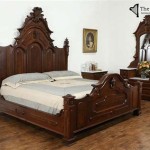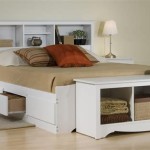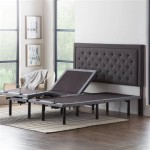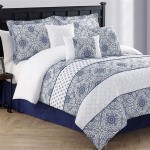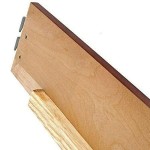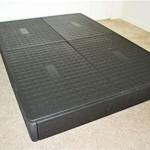Can You Use a Memory Foam Mattress on a Regular Bed Frame?
Memory foam mattresses have become increasingly popular due to their comfort and pressure-relieving properties. However, their unique construction sometimes raises questions about compatibility with existing bed frames. This article explores the factors determining whether a memory foam mattress can be used on a standard bed frame.
Slatted Bed Frames and Memory Foam Mattresses
Many standard bed frames utilize slats for support. These slats, typically made of wood or metal, provide a foundation for the mattress. While slats can work with memory foam, the spacing and thickness of the slats are crucial. Too much space between slats can cause the mattress to sag, negating the benefits of memory foam and potentially damaging the mattress over time. Conversely, sufficiently close slats provide adequate support, distributing weight evenly and preventing sagging.
For optimal support, slats should be no more than 2-3 inches apart. This close spacing prevents the memory foam from sinking between the slats. Additionally, the slats should be relatively sturdy to bear the weight of the mattress and the sleeper(s). Thin or flimsy slats may bend or break under pressure, leading to inadequate support and potential mattress damage.
Some memory foam mattresses require a center support beam in addition to slats, especially in larger sizes like queen or king. This center support beam provides extra stability and prevents sagging in the middle of the mattress. Check the manufacturer's recommendations for specific requirements.
Platform Bed Frames and Memory Foam Mattresses
Platform beds provide a solid, flat surface for the mattress, offering excellent support for memory foam. The continuous surface eliminates the concerns about slat spacing and ensures even weight distribution. This consistent support helps maintain the integrity of the memory foam and prolongs the mattress lifespan.
Platform beds often incorporate a built-in foundation, eliminating the need for a box spring or separate foundation. This streamlined design makes platform beds a convenient and aesthetically pleasing option for memory foam mattresses.
When choosing a platform bed for a memory foam mattress, consider the height of the platform and the desired overall bed height. Platform beds are available in various heights, allowing for customization based on personal preference and bedroom décor.
Box Springs and Memory Foam Mattresses
Traditional box springs, designed for innerspring mattresses, are typically not recommended for memory foam mattresses. Box springs offer uneven support and can cause the memory foam to compress unevenly, leading to discomfort and reduced mattress lifespan. The springs in the box spring can also damage the memory foam over time.
However, some manufacturers produce box springs specifically designed for memory foam mattresses. These specialized box springs feature a solid or closely spaced slatted surface, providing the necessary support and even weight distribution. When considering using a box spring with a memory foam mattress, it is crucial to verify that the box spring is explicitly compatible with memory foam.
Adjustable Bed Frames and Memory Foam Mattresses
Adjustable bed frames offer customizable positioning, allowing users to adjust the head and foot of the bed to various angles. Many memory foam mattresses are compatible with adjustable bed frames due to their flexible nature. The memory foam conforms to the changing shape of the adjustable frame, providing consistent support and comfort.
When selecting an adjustable bed frame for a memory foam mattress, ensure the mattress is designed for adjustable bases. Some mattresses have specific flexibility requirements for optimal performance on an adjustable frame.
Foundation and Support Considerations
Regardless of the bed frame type, adequate foundation and support are essential for the longevity and performance of a memory foam mattress. Proper support helps maintain the mattress's shape, prevents sagging, and ensures even weight distribution, promoting comfortable and restful sleep.
Always consult the manufacturer's recommendations for specific foundation requirements. The manufacturer's guidelines provide detailed information on compatible bed frames and foundations, ensuring optimal support and preventing potential damage to the mattress.
Assessing Your Current Bed Frame
Before placing a memory foam mattress on an existing bed frame, carefully assess the frame's condition and construction. Check for any signs of damage, weakness, or excessive spacing between slats. If the bed frame is old or damaged, replacing it with a suitable frame may be necessary to provide adequate support for the memory foam mattress.
Ensure the bed frame provides adequate support and weight distribution for the specific size and weight of the memory foam mattress. Larger or heavier mattresses may require a more robust frame to prevent sagging and ensure long-term performance.
Do Memory Foam Mattresses Need Box Springs Mattress Advisor
Does Memory Foam Need A Box Spring Mattress Makers
Guide On How To Choose The Best Platforms For Memory Foam Mattress
The 3 Best Platform Bed Frames Under 300 Of 2024 Reviews By Wirecutter
Do I Need A Bed Frame For My Memory Foam Mattress Leesa
What Type Of Bed Base Is Suitable For A Memory Foam Mattress Consultant
Flash Furniture 14 Inch Metal Platform Bed Frame With 12 Pocket Spring Mattress In A Box And 3 Cool Gel Memory Foam Topper Full Target
The 10 Best Modern Bed Frames Of 2024 Reviews By Wirecutter
Metal Bed Frame Simmons Tall 13 Mattress Base
Memory Foam Mattress 180 Night Trial Siena
Related Posts
